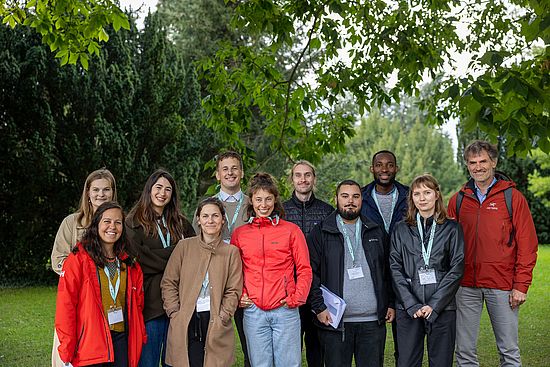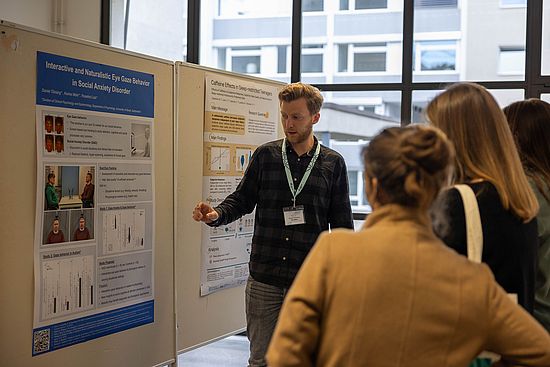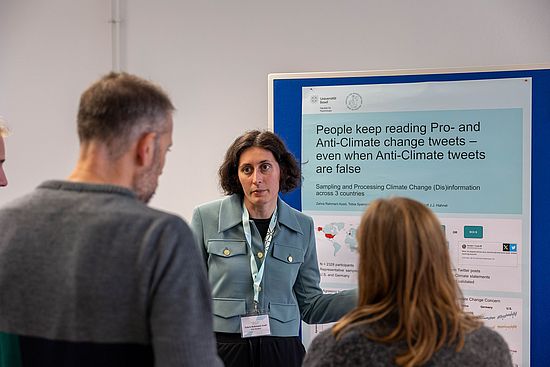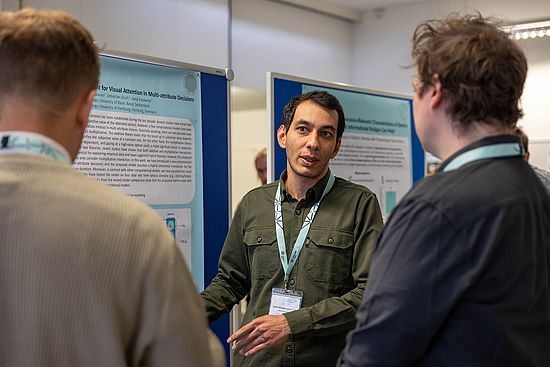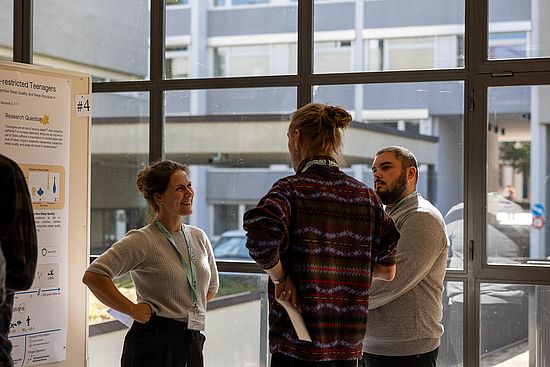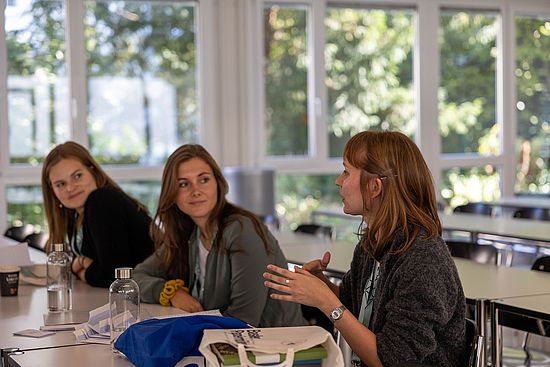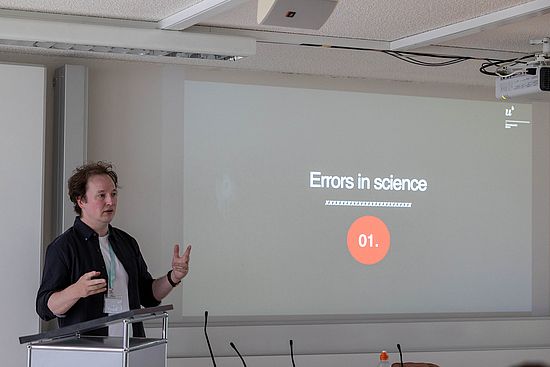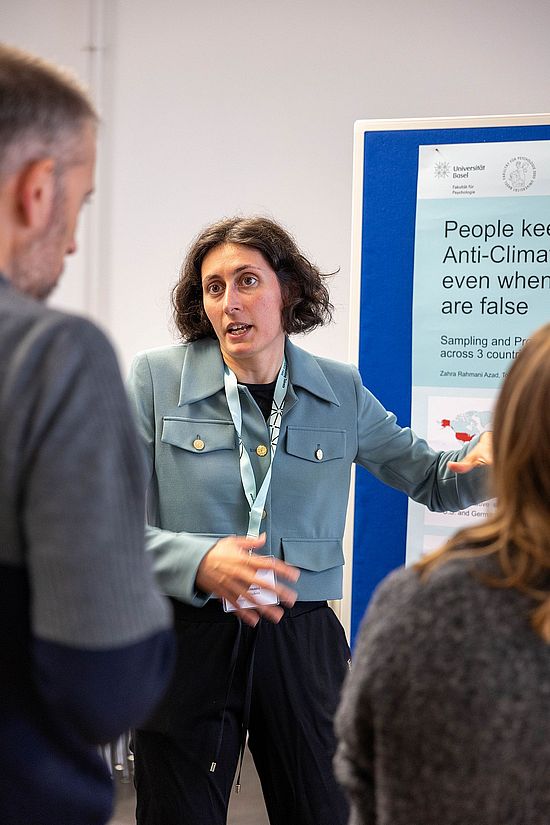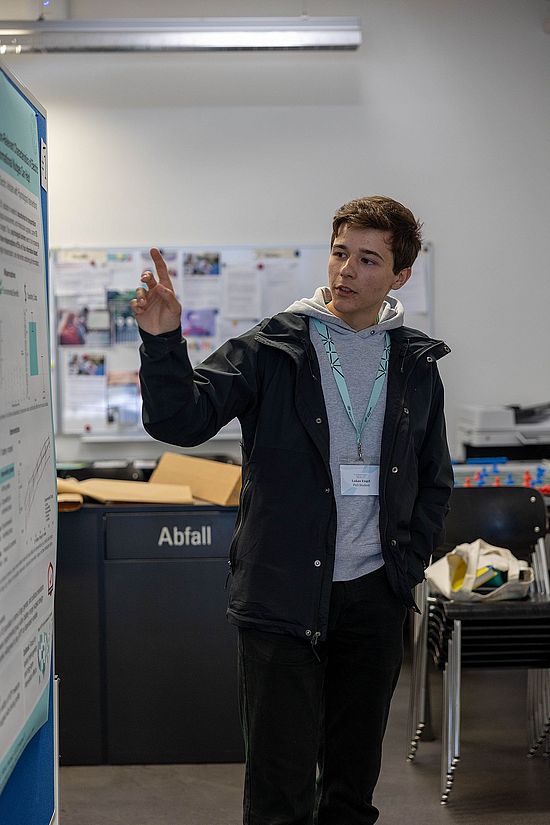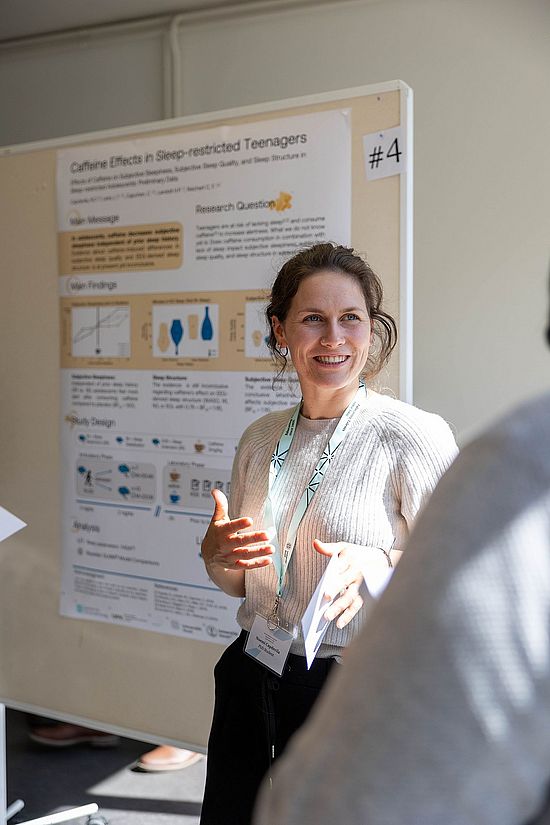Thank you for joining BEACON 2024!
Photos by @pupila.photography
Poster Awards
At BEACON 2024 following people recieved poster prizes:
Expert Award (rated by keynote speaker Ian Hussey): Zahra Rahmani Azad, "People equally sample and process climate change (dis)information in a polarized environment"
Best Scientific Contribution: Lukas Engel, "Counteracting misperceptions of battery-electric vehicles with behavioural interventions"
Most Visually Creative: Noëmi Capdevila, "Coffee before bedtime? Why not… - Preliminary Effects of Caffeine on subjective Sleepiness & Sleep Quality and Sleep Structure in sleep-restricted Adolescents"
Photos by @pupila.photography
Registered Poster Abstracts
Noëmi C. Capdevila, Lina T. Lane, Christian Cajochen, Hans-Peter Landolt, Carolin Reichert
Centre for Chronobiology, University of Basel, University Psychiatric Clinics Basel
Background: Approximately 50% of adolescents experience insufficient sleep, partly due to a mismatch between maturational changes in sleep-wake-regulation and social constraints. To combat daytime sleepiness, many adolescents consume caffeine. It is unclear whether acute caffeine intake reduces subjective sleepiness, subjective sleep quality, and whether it disrupts sleep under conditions of insufficient sleep duration.
Methods: In an ongoing EEG-study, we administered caffeine (2 mg/kg bodyweight, after a five-day abstinence) vs placebo three hours before bedtime in a within-subject design to two groups of adolescents (14-17years) after either two nights of sleep restriction (SR group, 6h bedtime, n=13) or sleep extension (SE group, 9.5h bedtime, n=7). After the treatment, we measured subjective sleepiness repeatedly and subjective sleep quality the next morning. We quantified nighttime sleep variables typically affected by caffeine (sleep efficiency, N1 and N3, wake after sleep onset, and sleep onset latency) in the first six hours of the sleep episode. We used Bayesian mixed model comparisons for analyses.
Results: Subjective sleepiness increased during the evening with high values before bedtime in both the SR and the SE groups. Caffeine reduced sleepiness compared to placebo. There is strong evidence that caffeine didn’t affect QOS. Finally, there was no evidence for caffeine-dependent sleep changes.
Conclusions: Our preliminary analyses suggest that independent of prior sleep opportunity adolescents feel more alert after consuming a caffeine. The evening increase of sleepiness was present irrespective of caffeine consumption. Subjective sleep quality was not affected by caffeine consumption. There is no evidence of caffeine affecting sleep structure.
Janine Bacher, Christina Stadler, Eva Unternaehrer, Donja Brunner
Department of Child and Adolescent Psychiatry, University of Basel
Background: Adolescent refugees are particularly vulnerable to mental health problems, as they experience many risk factors at crucial stages of their physical and emotional development. Despite having a greater healthcare requirement than others, they face significant barriers to accessing healthcare services. Therefore, this study aims to test the effectiveness of a low-threshold, culturally adapted version of the skills training START NOW – START NOW Adapted - in reducing mental health problems among adolescent refugees.
Methods: We will recruit 80 adolescent refugees (15 to 18years) with symptoms of anxiety and depression or high perceived stress in Northwestern Switzerland. They will be randomly assigned to one of two study groups: an intervention group, receiving START NOW Adapted, and a control group, receiving treatment as usual. The intervention will last 10 weeks and will consist of one-hour sessions per week provided by a trained facilitator with the same cultural background in the respective language. Assessments to collect depressive and anxious symptoms, perceived stress, social-ecological resilience, and emotion recognition abilities will be conducted pre-intervention, post-intervention (11 weeks later) and at the 3-month follow-up. Multilevel models will be computed with primary and secondary outcome measures as dependent variables.
Discussion: This randomized controlled trial is the first to date to investigate the effectiveness of the culturally adapted skills training START NOW, providing valuable insights to improve current health promotion of adolescent migrants in Switzerland. Ultimately, effects of START NOW Adapted may facilitate integration and promote healthy development while decreasing costs associated with treating migration- or conflict-related trauma.
Zahra Rahmani Azad, Tobia Spampatti, Sebastian Gluth, Kim-Pong Tam, Ulf J.J. Hahnel
Psychology of Sustainability and Behavior Change, University of Basel
Climate disinformation impedes climate action. On social media, polarized information environments display idiosyncratic and increasingly extreme content. Instead of actively seeking news, people often rely on information from algorithmic feeds.
In a preregistered information-sampling experiment, 2328 participants from the United States, Germany, and China sampled and rated real-world climate-related posts from opposing sources for 15 rounds. We test if people sample information in a one-sided or balanced way when opposing sources are presented side by side. We tested if sampling patterns showed a confirmation bias, i.e., favored information consistent with existing beliefs, and if sampling patterns affected climate concern.
Overall, both sources were chosen nearly equally. Prior climate change beliefs and concern positively predicted box choices, indicating a slight confirmation bias, and this effect got stronger in later rounds. Participants were more likely to switch to the other source when they agreed less with the previous statement. Agreement to a statement could be predicted from prior climate beliefs and became more accentuated in later rounds.
There were small significant effects of climate information type on climate change concern: Pro-climate statements increased and Anti-climate statements decreased within-person climate concern. This effect accumulated over 15 rounds, so that participants who sampled more Pro-climate statements showed increasing concern and vice versa. We find cascading effects where concern influences box choices which in turn influenced concern, but these effects were small against mostly stable levels of climate concern. People formed impressions about the sources after few rounds which influenced the perceptions of the statements.
Lukas Engel, Ola Elassal, Mario Herberz, Ulf Hahnel
Psychology of Sustainability and Behavior Change, University of Basel
The widespread adoption of battery electric vehicles (BEV) is a crucial step towards decarbonizing the transportation sector. Yet and despite purchase price decreases, technological advancements, and loading infrastructure upgrades, the current BEV diffusion is insufficient to meet emission mitigation targets and shows high spatial variance across and within countries. Therefore, psychological barriers seem to play an increasingly important role in hindering BEV uptake. In a US sample, we find evidence for significant underestimations of the battery range compatibility with individuals’ own mobility needs and the carbon emission benefits compared to conventional vehicles, as well as a significant overestimation of the yearly operating costs of BEVs compared to conventional vehicles. To counteract these misperceptions, we tested four tailored interventions which presented either one correcting information (i.e., actual range compatibility, actual difference in life cycle carbon emissions, and actual difference in yearly operating costs) or all three information combined. Their effectiveness was assessed based on seven willingness to pay measurements corresponding to seven battery ranges between 60 and 240 miles, while the reference point for the evaluation was a conventional vehicle. Across multiple analyses, we found robust positive effects of the intervention that combined all information and the range compatibility intervention, while findings for the operating costs intervention were mixed, and for the environmental benefits indicative of ineffectiveness. Based on these findings, adjustments to the interventions will be made to eventually investigate the spatial heterogeneity of BEV adoption within the US in future studies. This is supposed to inform effective policy-making.
Lucia Gasparovicova, Martin Steppan, Alexander Grob
Department for Personality and Developmental Psychology, University of Basel
Introduction. Adaptive emotion regulation (AER) in children and adolescents is associated with lower internalizing and externalizing problem behaviour (PB). There is evidence for this relation but it is unclear which factors contribute to this. One of the factors might be executive functions (EF), as expansions of Gross’ extended ER process model posit EF facilitating AER and mitigating PB. Furthermore, an intervention study in remitted depressed adults showed that EF training improved AER and lowered internalizing PB (Hoorelbeke et al., 2023). However, whether this is transferable to externalizing PB and to younger, typically-developing children and adolescents is unknown. The current study investigated whether EF moderated the relation between AER and externalizing and internalizing PB.
Methods. We utilized cross-sectional, observational data from N = 672 participants, aged five to 16 years from the Intelligence Development Scales 2 (IDS-2) study. We operationalized ER and EF with the IDS-2 and PB with the Strengths and Difficulties Questionnaire (SDQ). First, data analyses and visualization by GAM spline determined whether age and sex would be controlled for in the subsequent moderation. Then, we modelled a structural equation model (SEM) with simple moderation.
Results. Age and sex were significantly related to changes in all variables and were thus controlled for. The SEM showed that EF significantly moderated the relation between AER and internalizing and externalizing PB in participants. For AER and externalizing PB, the influence of participants’ sex was larger than the moderating effect of EF.
Discussion. Implications, limitations and suggestions for future research are discussed.
Hanzhang Xie, Karin Hediger
Clinical Psychology and Psychotherapy, University of Basel; Faculty of Behavioural Sciences and Psychology, University of Lucerne
Individuals face an increasingly large number of social and technological risks. How these risks are perceived is of critical interest for researchers and policymakers alike. In recent years, researchers have demonstrated that high-dimensional word embeddings derived from vast online text corpora can improve our understanding of, and ability to predict risk perception. Most notably, Bhatia (2019) has recently found machine learning models such as Word2Vec to be on par with more traditional, psychometric approaches to risk perception. However, text may not present the best available source of information to capture people's semantic representations. Research has found representations derived from free associations to be a promising alternative when predicting human judgments and behaviour than those derived from text. We begin by presenting a reanalysis of Bhatia (2019) but with two main differences. Firstly, to ensure a representative, up-to-date evaluation of text-based accounts, we employ more recent text-based models, which benefit from architectural improvements and a larger training set. Secondly, we add our own free association-based representations to the model comparison, trained on data from the Small World of Words study in English dataset. To train this model, we apply singular value decomposition to the positive pointwise mutual information-transformed cue-associate matrix. We then use cross-validation to evaluate the different representations’ ability to predict risk perception, and find that the free association-based representations are on par with the best performing text-based models, despite being trained on orders of magnitudes less data. We also find that an ensemble of the psychometric and semantic models can explain over 85% of the risk perception variance. Furthermore, analyses of how the semantic models’ predictive accuracy scale with the amount of training data indicates that higher performance can be achieved with participant ratings for a larger training set of risk sources than the 306 sources available in Bhatia’s data. As such, in our main study, we collect risk judgements for a set of 1006 risk sources, and evaluate model performance on this larger set of sources. Finally, we demonstrate the applicability of these newly fitted representations by employing them to analyse the riskiness of the language used in online articles – namely, UK parliament speeches – identifying patterns of changing risk perception over time that correspond to real-world events.
Keywords: risk perception, free association, semantic representation
Daniel Tönsing, Karina Wahl, Roselind Lieb
Department of Clinical Psychology and Epidemiology, University of Basel
Our eyes play a crucial role in nonverbal communication and social behavior, making the study of eye gaze behavior important for understanding cognitive processes and social functioning. One incident that is often associated with abnormalities in eye movements is Social-Anxiety-Disorder (SAD) with socially submissive behaviour like hyper scanning and avoidance of direct gaze and eyes.These findings originate primarily from Standard screen-based eye-tracking methods, while providing high experimental control, lack external validity and do not fully capture real-world interactions and if this patterns also occurs with regard to interactive gaze behavior has not yet been sufficiently investigated. To address this limitation, we will use a novel dual eye-tracking setup that allows for the assessment of naturalistic, interactive gaze behavior between two individuals while maintaining experimental control and high eye tracking data quality. This setup enables the analysis of both unidirectional gaze parameters (e.g., dwell time, fixations) and interactive gaze behaviors (e.g., mutual eye contact), providing insights into how we initiate, maintain, and interrupt eye contact. Furthermore, we still know very little about whether and to which extent specific treatments influence and change these gaze parameters. CBT is the treatment of choice, but access and wide individual variation in outcomes are challenging. Cognitive-Bias-Modification (CBM) is a novel experimental training that seeks to reduce negative Cognitive Biases (CB) by directly targeting cognitive mechanisms with actively practicing more adaptive interpretations and attentions attention shifts. We will investigate the effectiveness of CBM training for SAD on the interplay of objective behavioural parameters of SAD (gaze behaviour, physiology) to gain insight into whether and which specific parameters/abnormalities of naturalistic interactive gaze behaviour in SAD can be altered or reduced by CBM.

